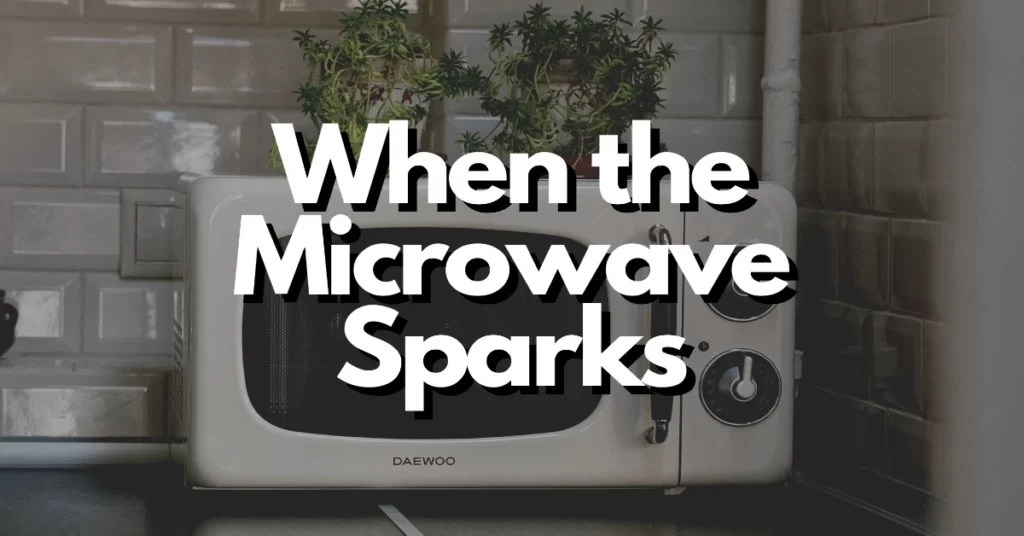Microwaves are a ubiquitous kitchen appliance, offering us quick and convenient ways to heat and cook our meals. However, there may come a day when you press that familiar button, and instead of a gentle hum, you’re met with sparks and unsettling noises. When your microwave starts sparking, it’s essential to take action promptly to ensure both your safety and the longevity of your appliance.
In this guide, we’ll explore the reasons behind microwave sparking, steps to address the issue, and when it might be time to consider a replacement. Whether you’re a kitchen whiz or a novice cook, understanding how to handle a sparking microwave is essential.
Why Is My Microwave Sparking?
Microwave sparking can occur for several reasons, and it’s crucial to identify the root cause before attempting any fixes. Here are some common reasons for sparking:
1. Metal Objects: Placing metal objects, such as aluminum foil or metal-trimmed dishes, inside the microwave can lead to sparks. Microwaves work by emitting electromagnetic waves that heat food through excitation of water molecules. Metal objects can cause electrical arcing, resulting in sparks.
2. Damaged Waveguide Cover: The waveguide cover is a protective panel that guides microwave energy into the oven cavity. When it’s damaged or has food splatter buildup, it can cause sparks.
3. Food Debris: Food residues or grease inside the microwave can lead to sparking if they come into contact with the microwave’s interior or its components.
4. Malfunctioning Stirrer Fan: Some microwaves have a stirrer fan that distributes microwave energy evenly. If this fan is malfunctioning or blocked, it can cause uneven heating and, in some cases, sparking.
5. Age and Wear: Over time, the interior components of a microwave can degrade or become worn out. As a result, sparking can occur due to faulty connections or deteriorated parts.
Immediate Actions When Your Microwave Sparks
If you notice sparking coming from your microwave, follow these steps immediately:
1. Turn Off the Microwave: Stop the microwave by pressing the “Stop” or “Cancel” button. If it doesn’t respond, unplug it from the electrical outlet.
2. Remove Metal Objects: If metal objects are sparking, open the microwave and carefully remove them with non-metallic utensils.
3. Inspect for Food Debris: Check the interior of the microwave for any food debris or splatters. If you find any, clean them thoroughly with warm, soapy water.
4. Examine the Waveguide Cover: Inspect the waveguide cover for damage or signs of wear. If it’s damaged or has significant buildup, it may need to be replaced.
5. Allow the Microwave to Cool: If the sparking has caused excessive heat, let the microwave cool down for at least 30 minutes before attempting to use it again.
When to Call for Microwave Repair
If the sparking continues even after following the immediate actions, it’s essential to seek professional microwave repair services. Attempting to repair the microwave yourself without proper knowledge can be dangerous. Here are signs that indicate you should call for microwave repair:
1. Persistent Sparking: If the microwave continues to spark despite removing any metal objects or cleaning the interior, it suggests an underlying issue that requires professional attention.
2. Strange Noises: Unusual noises like buzzing, crackling, or humming may indicate electrical or component problems that need inspection by a technician.
3. Inoperative Controls: If your microwave’s control panel becomes unresponsive or displays error codes, it’s a sign of electrical or electronic issues that require repair.
4. Burning Smells: If you detect burning odors when using the microwave, immediately stop using it and call for repairs. This could indicate a wiring problem or other electrical issues.
When to Consider Replacing Your Microwave
Microwaves are durable appliances, but like all machines, they have a lifespan. There comes a point when it’s more cost-effective and safer to replace your microwave rather than repairing it. Here are some situations when you should consider getting a new microwave:
1. Age: If your microwave is more than 5-10 years old and begins experiencing frequent issues, it might be time for an upgrade. Newer models are often more energy-efficient and offer advanced features.
2. Cost of Repairs: If the cost of repairing your microwave exceeds 50% of the price of a new one, it’s usually wiser to invest in a replacement.
3. Outdated Features: Older microwaves may lack modern features such as sensor cooking, convection cooking, or energy-saving modes. Upgrading to a newer model can enhance your cooking experience.
4. Safety Concerns: If your microwave poses safety risks, such as persistent sparking or electrical issues, it’s best to prioritize safety and invest in a new appliance.
Preventing Microwave Sparks
Prevention is often the best solution. To reduce the likelihood of your microwave sparking, consider these preventive measures:
1. Avoid Metal:
Never place metal objects, aluminum foil, or utensils in the microwave.
2. Keep It Clean: Regularly clean the interior of your microwave to remove food debris and splatters.
3. Use Microwave-Safe Cookware: Always use microwave-safe containers and dishes to heat or cook food.
4. Inspect and Maintain: Periodically inspect your microwave for signs of wear, damage, or buildup. If you notice any issues, address them promptly.
Conclusion
A sparking microwave can be a concerning sight, but by understanding the possible causes and taking appropriate action, you can often resolve the issue safely.
Remember to prioritize safety, especially if you encounter persistent sparking or unusual odors, and don’t hesitate to seek professional repair or consider replacing your microwave when needed. By doing so, you’ll ensure both your safety and the efficient operation of your kitchen appliance.
